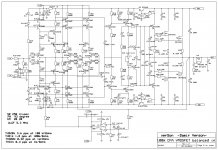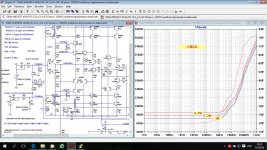I'm doing some boards that will go to the ISS and I got mild complaints that we had
spent €100K just for 100nF / 0603 capacitors. And I wanted a somewhat fast
JFET opamp and had to do it with discrete FETs and some normal opamps for
temp & offset compensation.. Trimmers simply do not exist, and normal parts may be
changed just _once_, with written reasoning and that goes through the entire hierarchy.
Radiation tests would have been cheap, but nobody was willing to do the the paperwork.
Yup, why I left the space industry for those new fangled digital mobile phones back in the early 90s. And why I always lauded the UoSat project where they just used stuff from RS and it worked!
I agree - balanced all the way. I don't know how Doug could force that blameless thing on the world when he had the opportunity to do a decent balanced design. Leach got it right back in the 70's all ready.
Can I just check what you mean by 'balanced' here? The one thing you very rarely see in a power amp is a balanced input unless its a couple of op-amps converting to single ended for the amp proper.
There is a substantial improvement just going to mylar from X7R. The huge improvement was the C0G in a time constant location, and those are tough to source in 1% but not unheard of.I'll betcha 10 to 1 you aint seen the last of your servo yet. I don't know your specs but if yer calling out special order giant SM C0Gs yer up against a few. the longer you wait for 'the phone call', the more chunks of skin off derrière will be paid.
Finally there are films to replace some less critical parts. Each one of these changes has been proven out with leaded films and each helped both distortion and noise (the latter from microphonics from the bench, probably).
So, no customs needed.
Can I just check what you mean by 'balanced' here? The one thing you very rarely see in a power amp is a balanced input unless its a couple of op-amps converting to single ended for the amp proper.
Of course there are two ways at least to interpret this. One is truly balanced input (not some bogus inverting stage to convert single-ended to push-pull). Keith Johnson used to manage this from the phono cartridge, or the tape head, to the loudspeaker. I also discussed with him the possible inference of the superiority of tubes based on the necessity of balanced topologies to achieve symmetrical large-signal response, with KOJ at the time expressing his heavy weighting of symmetrical slew rates as psychoacoustically important. I don't know offhand how this surmise or suspicion was determined, although Keith has fabulous ears and makes great recordings.
I think what may be more common, and was perhaps intended, is the distinction between single-ended complementary input stages, (and the following symmetries perhaps), versus the "blameless" single-diff-pair input stages.
LOL.
Prediction: MIT will never recover their reputation. Hell, the'll be lucky if the norms don't burn it down.
You mean the LED nonsense, there was an infamous kook years ago that (of course) died under mysterious circumstances?
Harvesting ambient light/heat/mechanical energy at the pico-Watt level is very au courant.
This makes me think of the ads I get all the time that say Watch this video before the forces of darkness (or words to that effect) have it taken down!You mean the LED nonsense, there was an infamous kook years ago that (of course) died under mysterious circumstances?
Harvesting ambient light/heat/mechanical energy at the pico-Watt level is very au courant.
As for steorn I don't pay attention to them, I've no idea what is going on in that.
Just asking that maybe you could revisit the stuff you throw out as turning us all on our heads. The university in the Philippines running their entire campus on water, etc. all of it BS.
I already said nonsense. Hey send me your money that's what I want.
Of course there are two ways at least to interpret this. One is truly balanced input (not some bogus inverting stage to convert single-ended to push-pull). Keith Johnson used to manage this from the phono cartridge, or the tape head, to the loudspeaker. I also discussed with him the possible inference of the superiority of tubes based on the necessity of balanced topologies to achieve symmetrical large-signal response, with KOJ at the time expressing his heavy weighting of symmetrical slew rates as psychoacoustically important. I don't know offhand how this surmise or suspicion was determined, although Keith has fabulous ears and makes great recordings.
I think what may be more common, and was perhaps intended, is the distinction between single-ended complementary input stages, (and the following symmetries perhaps), versus the "blameless" single-diff-pair input stages.
Is this one balanced enough?
Attachments
Is this one balanced enough?
The servo isn't. The power supply regulator isn't. But close 😛
Jan
At least, and I am easily confused.Of course there are two ways at least to interpret this.
Concur always likes his recordings. Although why he releases HDCD still when only windows media player can decode is beyond me...One is truly balanced input (not some bogus inverting stage to convert single-ended to push-pull). Keith Johnson <snip> I don't know offhand how this surmise or suspicion was determined, although Keith has fabulous ears and makes great recordings.
Ah I see. That makes more sense now.I think what may be more common, and was perhaps intended, is the distinction between single-ended complementary input stages, (and the following symmetries perhaps), versus the "blameless" single-diff-pair input stages.
Is this one balanced enough?
If I can handle 18dBu inputs then yes 🙂
I did mean to ask on the other thread how you were dealing with the peculiarities of the VFETs.
By balanced I mean symmetrical or complimentary. Input is single ended - feedback into the other side of the input stage. Truly balanced complementary designs probably best with VFA as with with CFA you have a lo z -input node to deal with.
Also, nothing wrong with using op-amps or perhaps THAT device to convert balanced to single ended!
MLLOYD, thanks for the comment. Will not have anything to show for a while - lots of stuff in the pipeline though.
🙂
Also, nothing wrong with using op-amps or perhaps THAT device to convert balanced to single ended!
MLLOYD, thanks for the comment. Will not have anything to show for a while - lots of stuff in the pipeline though.
🙂
Last edited:
Also, nothing wrong with using op-amps or perhaps THAT device to convert balanced to single ended!
That's how I am currently doing it and the THAT chips are marvellous at the job (although they can end up being the main distortion contributor when you are down to ppm levels). Just keep thinking there must be other ways to extend the balance, but I think thats tube amp thinking clouding my vision as Brad noted.
The servo isn't. The power supply regulator isn't. But close 😛
Jan
I don't get it, servo and power supply regulator(cap multiplier?) not balanced?
This is a balanced input to unbalanced symmetrical complementary power amp output. CMRR is quite good.
Attachments
Scott as usual just can't communicate. Look at the cite and I think you will find what I thought was humorous.
If I can handle 18dBu inputs then yes 🙂
I did mean to ask on the other thread how you were dealing with the peculiarities of the VFETs.
This is not PA, it will clip before 18dBu, what do you mean by handle?
What you are interested about VFET, I have no problem with them. I am listening all days the version of this amp with no balanced input and pure CFA mode.
By balanced I mean symmetrical or complimentary. Input is single ended - feedback into the other side of the input stage. Truly balanced complementary designs probably best with VFA as with with CFA you have a lo z -input node to deal with.
🙂
I am a bit confused here. I was thinking that single ended(contrary to push-pull) is single output transistor(or tube) and it should be in Class A for audio.
JLH 10W amp is single ended as I see it. That naming is mostly used in tube amps.
MiniDSP HD has pro level balanced outputs. As I'm moving to digital crossovers seems a good time to move to running interconnects hot. No logical reason, just cos I can 🙂This is not PA, it will clip before 18dBu, what do you mean by handle?
Mainly how sensitive Id to Vgs is with temperature as the curves are very close at sane bias levels. A bit of loud music to warm things up and your quiescent goes all over the shop. I don't really want to bias the output to 0.5A per device!What you are interested about VFET, I have no problem with them. I am listening all days the version of this amp with no balanced input and pure CFA mode.
- Status
- Not open for further replies.
- Home
- Member Areas
- The Lounge
- John Curl's Blowtorch preamplifier part II

